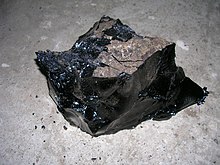Term: Bitumen
**Terminology and Etymology**:
– Bitumen is a viscous constituent of petroleum, also known as asphalt in the U.S. and classified as pitch.
– The term asphaltum was used before the 20th century, and the word asphalt traces back to ancient Greek.
– Latin, Sanskrit, Accadian, and other languages have contributed to the etymology of bitumen.
– Modern terminology differences exist between American, British, and Canadian English.
**Composition**:
– Bitumen consists of naphthene aromatics, polar aromatics, saturated hydrocarbons, and asphaltenes.
– It contains carbon, hydrogen, sulfur, organosulfur compounds, nickel, and vanadium.
– Additives, mixtures, and contaminants can impact the quality and properties of bitumen.
– Normal composition percentages and characteristics are well-defined.
**Occurrence and History**:
– Bitumen is primarily obtained from petroleum for commercial use.
– Natural deposits are found in locations like Trinidad and Tobago, Venezuela, and the Dead Sea.
– Significant reserves are present in Alberta, Canada, notably the Athabasca oil sands.
– Historical uses date back to Paleolithic times and were prevalent in ancient civilizations.
**Regional Development**:
– Continental Europe, the United Kingdom, the United States, and Canada have unique historical narratives around bitumen.
– Industrial development, medicinal properties, and early uses in photography and art are notable in these regions.
– Canada, with the Athabasca oil sands, has played a significant role in bitumen extraction and development.
**Industrial Applications and Environmental Impact**:
– Bitumen has been used for various industrial purposes like waterproofing, roofing, fuels, lubricants, and medicines.
– The environmental impact of bitumen extraction and use has been a subject of concern.
– Innovations in extraction techniques have aimed to reduce environmental implications and improve efficiency.
– The historical significance of bitumen extraction, like Dr. Karl A. Clark’s contributions, is tied to its environmental impact and technological development.
Bitumen (UK: /ˈbɪtjʊmɪn/ BIT-ew-min, US: /bɪˈtjuːmən, baɪ-/ bih-TEW-mən, bye-) is an immensely viscous constituent of petroleum. Depending on its exact composition it can be a sticky, black liquid or an apparently solid mass that behaves as a liquid over very large time scales. In the U.S., the material is commonly referred to as asphalt. Whether found in natural deposits or refined from petroleum, the substance is classed as a pitch. Prior to the 20th century the term asphaltum was in general use. The word derives from the ancient Greek ἄσφαλτος ásphaltos, which referred to natural bitumen or pitch. The largest natural deposit of bitumen in the world is the Pitch Lake of southwest Trinidad, which is estimated to contain 10 million tons.



70% of annual bitumen production is destined for road construction, its primary use. In this application bitumen is used to bind aggregate particles like gravel and forms a substance referred to as asphalt concrete, which is colloquially termed asphalt. Its other main uses lie in bituminous waterproofing products, such as roofing felt and roof sealant.
In material sciences and engineering the terms "asphalt" and "bitumen" are often used interchangeably and refer both to natural and manufactured forms of the substance, although there is regional variation as to which term is most common. Worldwide, geologists tend to favor the term "bitumen" for the naturally occurring material. For the manufactured material, which is a refined residue from the distillation process of selected crude oils, "bitumen" is the prevalent term in much of the world; however, in American English, "asphalt" is more commonly used. To help avoid confusion, the phrases "liquid asphalt", "asphalt binder", or "asphalt cement" are used in the U.S. to distinguish it from asphalt concrete. Colloquially, various forms of asphalt are sometimes referred to as "tar", as in the name of the La Brea Tar Pits.
Naturally occurring bitumen is sometimes specified by the term "crude bitumen". Its viscosity is similar to that of cold molasses while the material obtained from the fractional distillation of crude oil boiling at 525 °C (977 °F) is sometimes referred to as "refined bitumen". The Canadian province of Alberta has most of the world's reserves of natural bitumen in the Athabasca oil sands, which cover 142,000 square kilometres (55,000 sq mi), an area larger than England.
